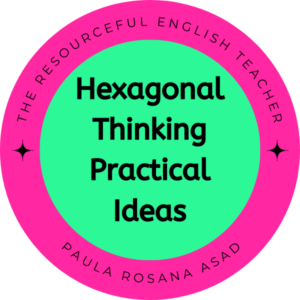Hexagonal Thinking Practical Ideas
Wondering what hexagonal thinking is? Do you know how to apply this fantastic strategy with your ESL students? Would you like to know the amazing benefits your students will get if they use it in class? If the answer is yes, then let’s dive in!
Developed by curriculum designer Betsy Potash, hexagonal thinking is a way to look at a problem from multiple perspectives, each represented by a different side of an hexagon. Students can make various connections on hexagonal tiles and arrange them so that related tiles are next to each other, building a web of connections.
For more information check out this video. CLICK HERE!

Some of the main benefits of hexagonal thinking include the following:
- Increased creativity: By considering different angles and perspectives, hexagonal thinking pushes students to come up with creative solutions they might not have thought of before.
- Enhanced communication: Hexagonal thinking helps learners to understand the perspectives of others and express themselves more effectively. This makes it easier to collaborate with others and develop a better solution.
- Knowledge Expansion: Students expand their knowledge and create new correlations between their schema and the new information.
Download for free this Hexagonal thinking template. Click here!
Some Activities you can do with your ESL students
- Activate Prior Knowledge: Have students activate prior knowledge by arranging hexagon cards before beginning a unit to get an idea of what students already know about a topic. Then, at the end of the unit, have students complete the hexagonal arrangement again to see how their thinking has expanded!
- Making connections: Whenever I want my students to link ideas in a text or to work to figure out a theme, I group them and give each group a series of hexagons filled with all of the significant elements from the text characters, symbols, ideas, events, etc. Next, students talk about how they can connect those words/concepts. Finally, they share their insights and reflections with the whole class.
- Getting to know each other: This activity can be done at the beginning of the year when students don’t know each other well. Students start by creating their own hexagons with information about themselves (favorite book, movie, interests), then they work in small groups to begin connecting their hexagons. Are there two people who love the same music? Who both want to travel to Mexico one day? They arrange their hexagons so that the sides that match ideas from other people connect, creating an interconnected web.
- Brainstorming for writing: Give students time to fill hexagons with their thesis, big ideas, research, counterarguments, etc., and begin moving them around to create a complex web. Then have them snap a photo or glue or tape their hexagons onto a larger piece of paper to act as the guiding inspiration for their writing.
By now, your brain is probably spinning with ideas of how to use hexagonal thinking in your classroom. If you liked this blog post, share it with your teacher friends.
Happy teaching!

